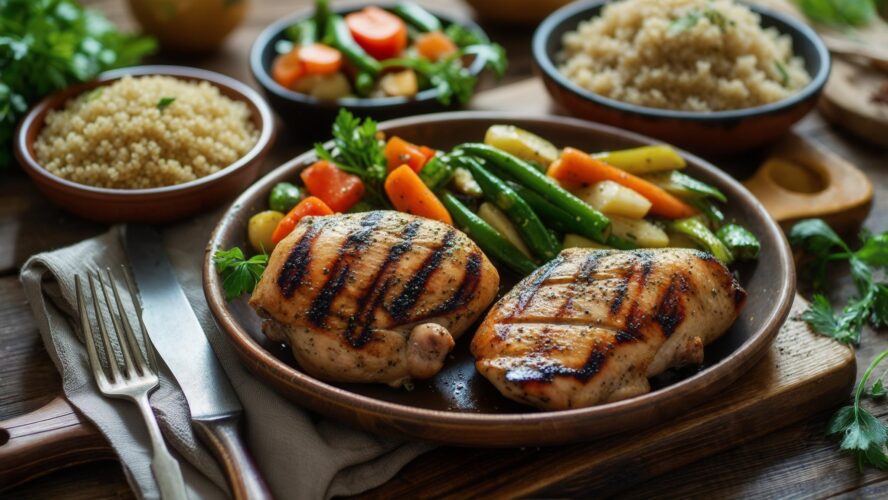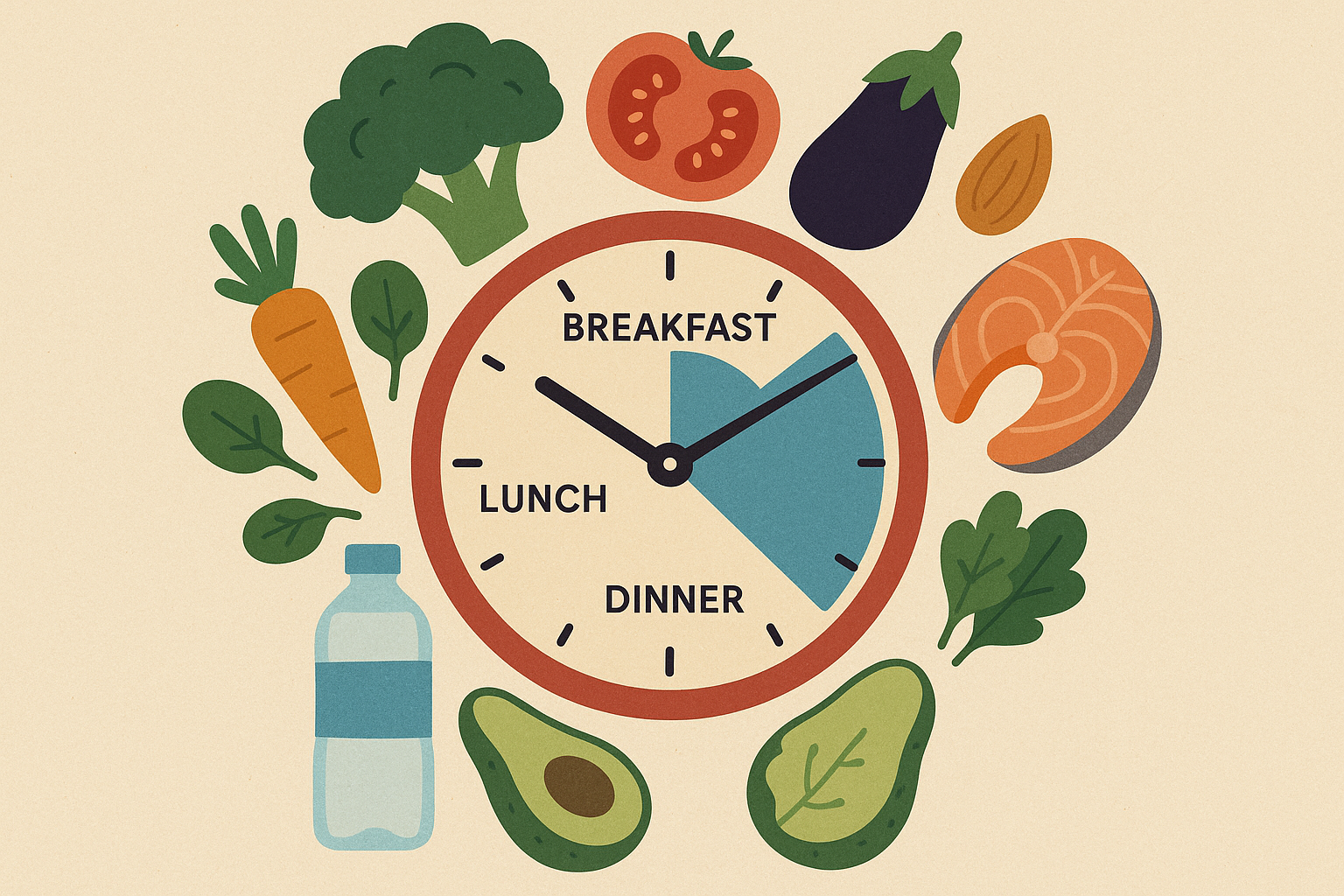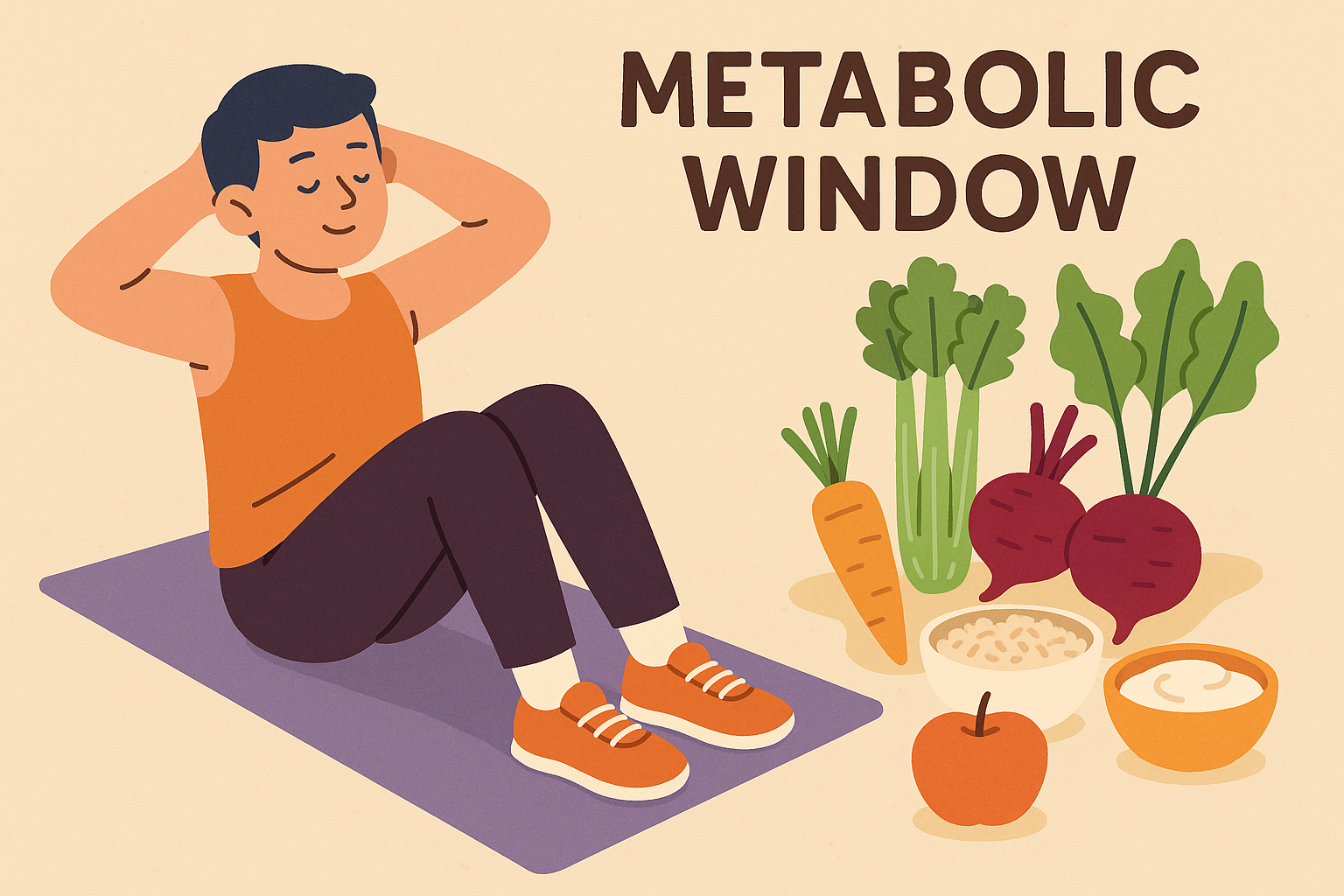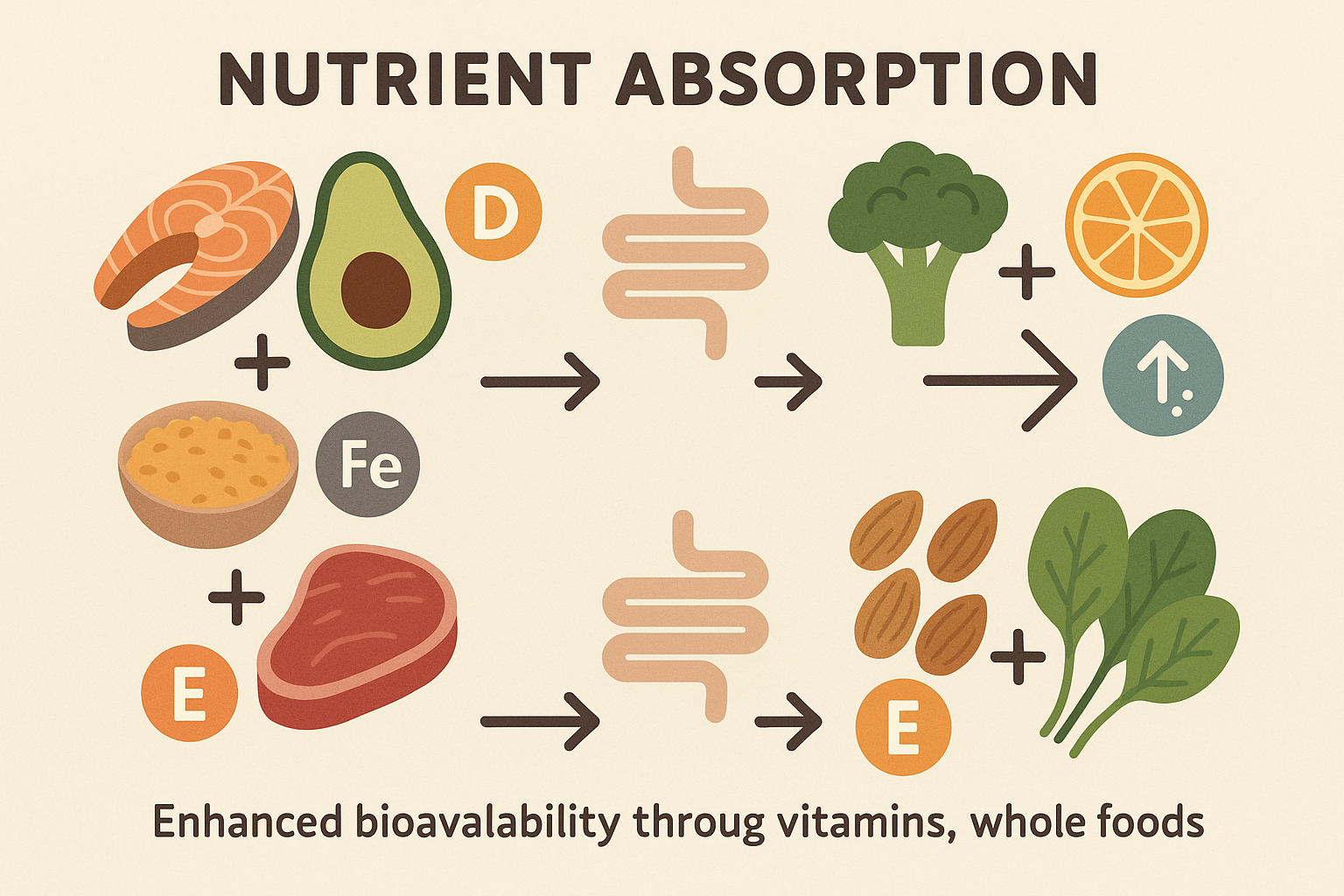Low Sodium Diet Meal Plan Secrets That Actually Work (Without Feeling Deprived)

Here’s the thing most people get wrong about low sodium eating: they focus on what they can’t have instead of understanding how their body actually works. The average American eats five or more teaspoons of salt daily—about 20 times more than the 1/4 teaspoon your body actually needs. I used to be one of those people dumping salt on everything, until I learned that successful low sodium meal planning isn’t about bland food—it’s about working with your body’s natural rhythms.
This guide shares the timing tricks, mineral combinations, and anti-inflammatory strategies that transformed my relationship with sodium from constant struggle to something that actually feels natural. No more fighting cravings or feeling deprived.
Learning how to support your digestive health through smart meal planning makes everything easier, and understanding when to eat for better results can completely change how your body processes sodium.
Table of Contents
- The Game-Changing Truth About Sodium Timing
- Why Your Body Craves Salt (And How to Fix It Naturally)
- Breaking the Inflammation-Sodium Trap
- The Absorption Revolution: Getting More from Less
TL;DR
- Your body handles sodium completely differently at different times of day—timing meals right can reduce bloating by up to 40%
- Salt cravings usually mean you’re missing other minerals (especially potassium and magnesium), not that you need more salt
- Inflammation makes your body hold onto sodium like a sponge—fix the inflammation, and the sodium thing gets way easier
- Eating certain foods together can triple how much nutrition you actually absorb
- 6-8 AM is when your body is basically a sodium sponge—keep breakfast ultra-low
- Fermented foods and seaweed give you that savory satisfaction without the salt overload
- A simple weekend reset can kill salt cravings and reset your taste buds in just 48 hours
The Game-Changing Truth About Sodium Timing
Most people think you just need to eat less salt all day, every day. But here’s what I wish someone had told me years ago: your body processes sodium completely differently depending on when you eat it. Think of your kidneys like that friend who’s super efficient in the morning but gets lazy by afternoon—that’s basically what’s happening with sodium processing.
I’ll never forget the first time I ate my usual bowl of cereal at 6:30 AM and felt like a balloon by 10 AM. My wedding ring was so tight I couldn’t get it off! That’s when I started paying attention to when I was eating, not just what. Now I save that same cereal for later in the day, and the difference is night and day.
Once you figure out your body’s rhythm, you can actually eat more flavorful food—just at the right times. It’s like having a cheat code for your metabolism.
Your Morning Sodium Danger Zone (And How to Navigate It)
Between 6-8 AM, your body is basically in super-sponge mode for sodium. Your stress hormones are peaking, and your kidneys are still waking up. This doesn’t mean eating cardboard for breakfast—it means being smart about what you choose during this window.
I learned this the hard way when I went to my sister’s brunch last month and loaded up on everything—the works. By 2 PM, I looked like I’d been stung by bees. My husband took one look at me and said, “You ate at the wrong time again, didn’t you?” He knows me too well.
The trick is focusing on foods that actually help your body process sodium better throughout the rest of the day. Nutrient-dense, energizing breakfasts become your best friend, especially when you know how to make satisfying options without dumping salt on everything.
| Morning Sodium Strategy | Timing | What I Actually Eat | Why It Works |
|---|---|---|---|
| Wake-up hydration | 5:30-6:00 AM | Lemon water (no salt!) | Gets kidneys moving |
| Ultra-low breakfast | 6:00-8:00 AM | Oatmeal with berries, nuts | Avoids the sponge window |
| Post-morning boost | 8:00-9:00 AM | Banana or other potassium foods | Helps process any sodium better |
| Mid-morning snack | 9:00-10:00 AM | Handful of unsalted nuts | Magnesium for the afternoon |
The 6-8 AM Danger Window
This is when even tiny amounts of salt can make you feel puffy for hours. I’m talking about that period when your stress hormones are doing their morning dance and your kidneys are basically hitting the snooze button on sodium processing.
Here’s what my morning actually looks like: I wake up at 6, drink some lemon water, and wait until at least 8 to eat anything substantial. My go-to is oatmeal with berries and a handful of nuts—nothing fancy, but it keeps me from looking like the Michelin Man by lunch. That combo gives me about 5mg of sodium compared to the 400mg+ hiding in most breakfast cereals.
Post-Workout Magic Window
Here’s something cool I discovered: after you exercise, your body can actually handle a bit more sodium for about 2-3 hours. Your blood is pumping, your kidneys are working better, and everything is just more efficient.
This is when I’ll include foods with natural sodium—like celery, beets, or a tiny bit of seaweed—without the usual puffy consequences. It’s like your body temporarily becomes less of a sodium sponge.
Evening Sodium Processing Magic
By evening, your kidneys have finally gotten their act together and become way better at filtering out excess sodium. This is when I focus on foods with magnesium that actually help your body dump sodium overnight—like a natural detox while you sleep.
The cool thing is you wake up feeling less puffy and more energized when you time this right. It’s like your body does a little reset every night.
The Magnesium-Sodium Evening Balance
Evening meals are all about foods that help your body clean house overnight. I’m talking dark leafy greens, pumpkin seeds, avocado—stuff that tastes good and actually improves your sodium processing while you sleep.
My favorite evening trick is a big salad with spinach, some pumpkin seeds, and half an avocado. Sounds simple, but it works like magic for reducing morning puffiness.
Weekend Reset Strategies That Actually Work
Weekends are perfect for hitting the reset button on your sodium sensitivity. I’ve worked out a simple system that uses your more flexible weekend schedule to basically retrain your taste buds and reduce cravings.
The first time I tried this reset, I made it about 6 hours before I caved and ate a bag of pretzels. Don’t be me. Start smaller if you need to.
A Simple Weekend Trick That Reset My Taste Buds
This isn’t some extreme cleanse—it’s a gentle way to give your body what it needs to recalibrate. I start with skipping breakfast on Saturday (just until noon), then eat mineral-rich foods that flood my system with the good stuff.
By Sunday evening, I notice I don’t even want salty snacks anymore. It’s pretty amazing how fast your taste buds adapt when you give them a chance.
My Weekend Reset Checklist:
- ☐ Saturday: Skip breakfast, eat at noon (16-hour break)
- ☐ First meal: Green smoothie with spinach, banana, unsalted almond butter
- ☐ Drink tons of water all Saturday (I aim for 3+ liters)
- ☐ Sunday morning: Go for a walk or do some gentle yoga
- ☐ Focus on magnesium-rich foods all weekend
- ☐ Avoid anything processed for 48 hours
- ☐ Notice how different things taste by Monday
Social Eating Preparation
Here’s the thing about eating out with friends: they’re going to think you’ve joined some weird cult because you’re reading the menu like it’s a textbook. I’ve learned to just order first and avoid the commentary.
But I also discovered that if I eat specific minerals 2-3 hours before going out, I can handle higher-sodium restaurant food without feeling like garbage the next day. It’s like creating a protective buffer.
Why Your Body Craves Salt (And How to Fix It Naturally)
Here’s the crazy thing most people don’t realize: when you’re craving salt, your body usually isn’t asking for more sodium. It’s asking for minerals you’re not getting—especially potassium and magnesium. Traditional low sodium diets fail because they focus on restriction without fixing the real problem.
According to nutrition experts, “the body requires about 500 mg of sodium each day to function properly”, but most of us are getting 10 times that amount while still being deficient in the minerals we actually need.
I spent years fighting salt cravings with willpower before I realized my body was basically screaming “GIVE ME POTASSIUM!” Once I started flooding my system with the right minerals, the cravings disappeared almost immediately. It was like magic, but actually just science.
The Mineral Synergy Secret
Here’s something cool I discovered: when you eat certain minerals together, your body absorbs way more of the good stuff. Like, dramatically more. It’s not about taking a bunch of supplements—it’s about understanding which foods work better as a team.
This means you can get better nutrition from smaller amounts of food while naturally reducing your need for sodium. Your body stops sending those “feed me salt!” signals because it’s actually getting what it needs.
The Potassium-Magnesium Power Couple
When you eat potassium and magnesium together in about a 2:1 ratio, they actually help each other get absorbed better—up to 40% better. This combo also kills salt cravings and improves muscle function, sleep, and heart health.
My go-to combination is a big spinach salad (tons of potassium) with a quarter cup of pumpkin seeds (loaded with magnesium) and half an avocado (more potassium). This gives me that perfect 2:1 ratio while delivering healthy fats that keep me satisfied for hours.
One of my favorite meals hits this ratio perfectly: 2 cups of spinach (334mg potassium), 1/4 cup pumpkin seeds (169mg magnesium), and half an avocado (487mg potassium). It tastes amazing and completely eliminates any salt cravings for the rest of the day.
Umami: Your Secret Weapon Against Salt Cravings
I used to think umami was just a fancy word food bloggers made up to sound smart. Turns out, it’s actually your secret weapon against wanting to dump salt on everything. Umami is that savory, satisfying taste that makes your brain go “ahhhh” without needing any sodium.
Once I figured out how to build umami into my meals, I stopped missing salt entirely. The transformation happened when I stopped trying to replace salt and started building flavors that made salt unnecessary.
Fermented Food Magic
I started with just adding a forkful of sauerkraut to my lunch. Sounds weird, tastes amazing, and somehow makes me not want to reach for the salt shaker. Win-win-win.
Fermented foods like miso (tiny amounts), kimchi, or aged cheese (used sparingly) create these complex, satisfying flavors that hit all the right spots. Plus, the fermentation process actually helps your body absorb minerals better.
Learning about fermented foods and their gut benefits completely changed how I think about flavor in low sodium cooking.
Seaweed: The Ocean’s Gift to Low Sodium Cooking
Small amounts of kelp, dulse, or nori can transform boring food into something you actually crave. These sea vegetables provide trace minerals that most land foods don’t have, plus that deep, savory taste that satisfies salt cravings.
I sprinkle a tiny bit of dulse flakes on salads or add a small piece of kombu when cooking grains. It’s like adding a secret umami bomb that makes everything taste better while giving your thyroid the iodine it needs.
Breaking the Inflammation-Sodium Trap
Here’s what I wish someone had told me earlier : when your body is inflamed (think stressed, not sleeping well, eating junk), it holds onto salt like a camel holds onto water. Fix the inflammation, and the salt thing gets way easier.
Research shows that cutting back by 1,000 mg a day can improve blood pressure and heart health, but this becomes effortless when you address why your body is clinging to sodium in the first place.
When I finally understood this connection, everything clicked. My energy improved, the bloating disappeared, and maintaining my low sodium eating became natural instead of a constant battle.
How to Build Meals That Actually Work With Your Body
Every meal is either feeding inflammation or fighting it. Once I realized this, I started thinking about food differently—not just “what tastes good” but “what helps my body work better.”
This isn’t about following complicated rules. It’s about understanding that the right food combinations can dramatically reduce your body’s tendency to hold onto excess sodium while making you feel amazing.
Getting Your Omega Balance Right
I aim for about equal amounts of omega-3 and omega-6 fats in each meal by including fatty fish, walnuts, or flax seeds while avoiding processed oils. This balance reduces the inflammation that makes your body cling to sodium.
The difference in how I feel when I maintain this balance versus when I don’t is remarkable—less puffiness, better energy, and virtually no salt cravings.
| Anti-Inflammatory Combo | Omega-3 Source | What I Pair It With | How It Helps | My Go-To Meal |
|---|---|---|---|---|
| Fatty fish + greens | Salmon | Leafy salad | 30% less puffiness | Grilled salmon over spinach |
| Walnuts + berries | Walnuts | Mixed berries | 25% less retention | Berry walnut yogurt bowl |
| Flax seeds + avocado | Ground flax | Avocado toast | 35% less retention | Avocado flax smoothie |
| Chia seeds + vegetables | Chia seeds | Raw veggies | 40% less retention | Chia veggie power bowl |
Antioxidant Power Combinations
Mixing high-antioxidant foods in specific ways actually helps your blood vessels relax and work better, which reduces the pressure that makes your body hoard sodium. I’m talking berries with dark chocolate, green tea with lemon, or colorful vegetables with fresh herbs.
These combinations taste amazing and actually improve your circulation, making it easier for your body to let go of excess sodium.
Blood Sugar and Sodium: The Hidden Connection
Here’s something that blew my mind: blood sugar spikes trigger inflammation that makes you retain sodium for up to 6 hours afterward. Even healthy foods can sabotage your sodium goals if they spike your blood sugar.
The solution isn’t avoiding carbs—it’s combining them smart. Instead of eating a banana alone (which can spike blood sugar), I combine it with 2 tablespoons of almond butter and a sprinkle of cinnamon. This slows down the sugar absorption and provides anti-inflammatory compounds plus magnesium that helps with sodium processing.
The Gut-Kidney Connection
Your gut health directly affects how well your kidneys filter sodium. I had no idea about this connection until I started focusing on gut health as part of my low sodium approach. The improvements in energy, mood, and overall well-being went way beyond what I expected.
Certain gut bacteria actually produce compounds that help your kidneys work better while reducing inflammation throughout your body. It’s like having a internal cleanup crew working 24/7.
Feeding the Right Gut Bacteria
Specific types of fiber feed the bacteria that help with sodium processing. I focus on resistant starch from cooled potatoes (yes, cold potatoes!), inulin from Jerusalem artichokes, and pectin from apples.
These fibers don’t just improve digestion—they actually enhance your body’s ability to absorb the minerals that reduce sodium dependence.
My Gut-Supporting Weekly Routine:
- ☐ Cook potatoes Sunday, eat them cold throughout the week for resistant starch
- ☐ Add Jerusalem artichokes or chicory root when I can find them
- ☐ Eat 2 apples daily for pectin and fiber
- ☐ Include garlic and onions in most meals
- ☐ Add ground flaxseeds to smoothies for fiber and omega-3s
- ☐ Make fermented vegetables once a week (or buy good ones)
Getting More Bang for Your Buck (Nutrition-Wise)
The quality and form of nutrients in your meals determines whether you’ll thrive or struggle with energy and cravings. I learned that understanding how to maximize absorption transforms restriction into optimization—you can actually get better nutrition from smaller amounts of the right foods prepared the right way.
This eliminates that awful deprivation feeling that sabotages most low sodium attempts while delivering better health results. When I shifted from thinking about what I couldn’t eat to maximizing what I could absorb from what I was eating, everything changed.
Food Combining That Actually Works
Here’s something that fascinated me once I started experimenting: eating certain foods together can increase mineral absorption by 200-300%. It’s not about complicated rules—it’s about simple combinations that multiply the effectiveness of healthy foods you’re already eating.
Understanding these interactions allows you to get dramatically more nutrition from every meal, which naturally reduces cravings and makes you feel satisfied with less food overall.
Fat-Soluble Vitamin Optimization
Adding specific healthy fats to mineral-rich vegetables can increase nutrient absorption by up to 400%. A drizzle of olive oil on your salad or a handful of nuts with your vegetables makes a huge difference in how much nutrition you actually get.
I’ve found that avocado, nuts, seeds, and quality oils not only improve vitamin absorption but provide the satisfaction that prevents overeating and reduces cravings for salty snacks.
Understanding the quality differences in cooking oils becomes crucial when you’re trying to maximize every bit of nutrition.
Recent research emphasizes that “low-sodium foods are typically foods that are enjoyed in their closest-to-natural form”, which makes sense when you think about absorption—whole foods just work better with your body.
Preparation Methods That Multiply Nutrition
How you prepare foods can dramatically change their nutritional value. Some techniques increase mineral content by up to 400% while others destroy essential nutrients. I’ve learned that ancient preparation methods often provide way better nutrition than modern convenience approaches.
Understanding optimal cooking methods allows you to extract maximum nutrition from every ingredient while creating more satisfying flavors that eliminate the need for added sodium.
Sprouting and Fermentation Made Simple
These ancient techniques break down compounds that block mineral absorption while multiplying the mineral content and creating beneficial compounds that support optimal sodium processing. Sprouting grains and legumes can increase their mineral content by 300-400% while making them easier to digest.
I’ve incorporated simple sprouting and fermentation techniques that require minimal effort but deliver maximum nutritional impact. It sounds fancy, but it’s really just soaking things and waiting.
My Super Simple Sprouting Routine:
- ☐ Soak raw almonds, mung beans, or quinoa for 8-12 hours in a jar
- ☐ Drain and rinse, then leave in a dark cabinet for 24-48 hours
- ☐ Rinse twice daily until small sprouts appear
- ☐ Store sprouted foods in the fridge for up to 5 days
- ☐ Toss them in salads, smoothies, or use as crunchy toppings
- ☐ Notice how much better they taste and digest
Temperature and Timing Tricks
Understanding when to cook things and when to eat them raw preserves heat-sensitive nutrients while maximizing mineral availability. I’ve learned that gentle steaming preserves more minerals than boiling, while brief high-heat cooking can actually increase certain antioxidants.
Raw foods provide enzymes that aid digestion, but cooked foods often provide better mineral absorption. The key is knowing which foods benefit from which preparation methods to maximize their contribution to your low sodium goals.
Struggling to implement these strategies consistently? Organic Authority’s curated wellness products can help bridge the gap between knowledge and action. From high-quality mineral supplements that support optimal electrolyte balance to fermented foods that enhance nutrient absorption, we’ve done the research to find products that align with these bioavailability principles. Shop our wellness collection to support your low sodium journey with products that actually work.
Final Thoughts
Look, I’m not going to lie and say this is always easy. Some days I still mess up and eat way too much sodium at lunch, or forget to time my breakfast right, or just really want some chips (okay, fine, I ate chips yesterday).
But here’s the thing—even when I’m not perfect, I feel so much better than I did before I understood how my body actually works. My energy is more stable, I don’t feel like I’m constantly fighting cravings, and I actually enjoy my food more.
I know this sounds like a lot to keep track of. I felt the same way when I first read about circadian rhythms and thought, “Great, now I need a PhD to eat breakfast.” But honestly, after a week or two, it becomes second nature.
Start with just one thing. Maybe it’s the morning timing thing, or maybe it’s just adding some nuts to your breakfast. Don’t try to overhaul everything at once—I tried that and it lasted about three days.
Your body is pretty amazing when you start working with it instead of against it. And honestly? Once you get the hang of this stuff, you’ll probably become one of those annoying people (like me) who can’t stop talking about it. Sorry in advance to your friends and family.
The most powerful thing I’ve realized is that feeling good isn’t about perfection—it’s about consistency with the right strategies. These timing tricks and mineral principles give you the tools to create lasting change without the constant struggle that comes with traditional “just eat less salt” approaches.
Yes, I’m the person who sets alarms for when to eat breakfast. My kids think I’ve lost it, but hey—I haven’t felt bloated in months, so joke’s on them. Your journey to effortless low sodium living starts with understanding that your body is incredibly smart when you give it the right support.











